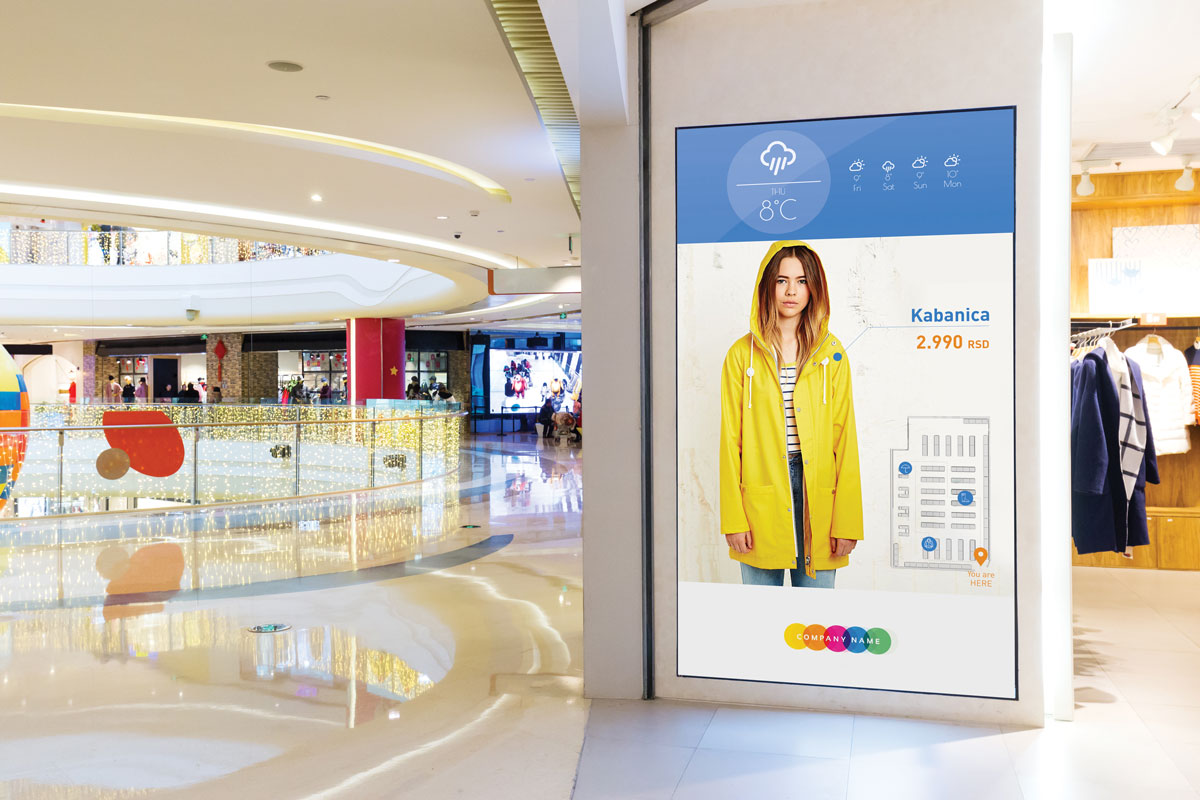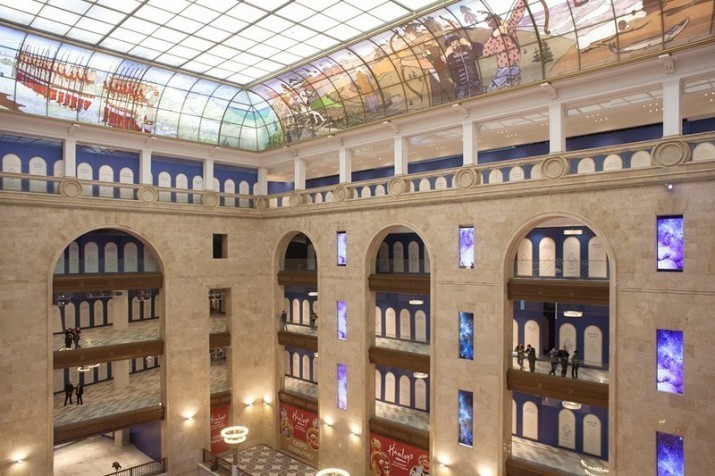
Ovaj interaktivan, multifunkcionalan vid komuniciranja osim što predstavlja produženu ruku prodajnih aktivnosti i doprinosi generisanju dodatne prodaje, može i da zadovolji različite potrebe kupaca.
Bez obzira da li govorimo o malim prodajnim objektima, hipermarketima ili tržnim centrima jedno je sigurno – strateški postavljeni displeji mogu da budu nezamenljiv kanal komunikacije između prodavca i kupaca.
Ovaj interaktivan, multifunkcionalan vid komuniciranja osim što predstavlja produženu ruku prodajnih aktivnosti i doprinosi generisanju dodatne prodaje, može i da zadovolji različite potrebe kupaca.
Za manje maloprodajne objekte digitalni displeji su pre svega način da se zaradi od izdavanja reklamnog prostora. Pošto mogu da se postave na ekskluzivne i vidljive lokacije, to ih čini atraktivnim izborom za veliki broj kompanija. Samom prodajnom objektu mogu da posluže za promovisanje akcija ili pružanje drugih informacija prolaznicima – događaji u gradu, radovi na putu, gužve u saobraćaju. Privlačenjem pažnje lakše se stvara ambijent za prodaju.
U velikim objektima displeji imaju dodatne funkcije. Pored reklamnog prostora namenjenih dobavljačima, kako bi se izdvojili iz bogate ponude hipermarketa, oni se postavljaju na specifična odeljenja kao što su delikates ili odeljenje tehnike da bi prikazivali određeni proizvodi, ili akcije sa konkretnog odeljenja. Dodatno mogu da služe i za plasiranje informacija čiju korist potrošači lako mogu da prepoznaju i koja u isto vreme može da ih navede da kupe baš ono što je u trenutnom prodajnom planu objekta.
Neka istraživanja sprovedena u Holandiji kažu da preko 90% kupaca nema ideju šta će da kupi, pre nego što krenu u kupovinu. Recepti na displejima služe da im predlože namirnice i olakšaju odluku za pripremu porodičnog ručka, a sve na osnovu raspoložive ponude u određenom segmentu objekta.
Pored očiglednih prodajnih kapaciteta digitalni displeji se postavljaju pored kasa, čime bi animirali kupce dok čekaju u redovima. Iako nemaju za cilj povećanje prodaje, imaju drugu bitnu funkciju. Pojedine studije su pokazale da smanjuju percepciju vremena provedenog u čekanju za čak 35%. Zbog toga kupci zadovoljniji izlaze iz objekta i rado se u isti vraćaju.
Najinteresantnija primena digital signagea su digitalne kabine za presvlačenje. U njima se nalaze u obliku običnih ogledala koja su u isto vreme i digitalni ekrani koji prikazuju određeni sadržaj. Kada u potrazi za farmerkama izaberete par koji vam se čini odgovarajućim, kabina ne mora da bude samo mesto gde ćete ih probati. Ekran u kabini može da prepozna bar kôd ili tag na etiketi pomoću bluetooth ili RFIDtehnologije i prikaže vam kompatibilne proizvode, npr. odgovarajuću košulju.
Pre nego što nešto probate može i da vam dâ ideju kako će to da izgleda na vama i pomogne da odlučite da li vam to odgovara i pre nego što krenete u ponekad mučan proces isprobavanja. Prodavnica dobija mogućnost da promoviše više proizvoda svakom konkretnom kupcu i u isto vreme da ga animira. Kupci, sa druge strane, mnogo lakše i jednostavnije vide raspoložive proizvode, štede vreme u traženju i brže obavljaju željenu kupovinu.
Iznad svega, ovo je odličan marketinški trik, s obzirom da nova tehnologija uvek privlači ljude. Zbog nje će više vremena provesti u objektu, potencijalno obaviti više kupovine, biti zadovoljniji celim iskustvom i opet se rado vratiti.
Ova funkcionalnost može da se nadogradi tako da ekran postane potpuno interaktivan. Kupac na ekranu može da isprobava različite kombinacije, ili čak da preko njega komunicira sa prodavcem. Nakon što preko ekrana izabere model i broj, šalje se informacija na mobilni računar prodavca, koji onda artikle donosi u kabinu. Ovako se otvara mogućnost da kupac proba i kupi više stvari, dok se ceo proces kupovine ubrzava i pojednostavljuje. Dodatno, može da pruži informaciju o raspoloživosti modela i traženog broja na drugoj lokaciji, ukoliko ga nema na stanju i omogući rezervisanje.
Komunikacija jedan na jedan nije sve čemu ovi digitalni displeji služe. Kad su kabine otvorene koriste se kao klasičan reklamni kanal.
Ovo je ujedno jedna od najfascinantnijih primena digital signagea u maloprodaji.
Osnovni cilj ekrana je promocija, postizanje dodatne prodaje i animiranje kupaca da što više vremena provedu u objektu.

Jedan dobar primer za to je najveća robna kuća igračaka u Moskvi, „Dečiji svet“ na Lubjanka trgu. Sa uloženih nekoliko miliona evra, više od 600 ekrana i 30 video zidova animiraju posetioce, najpre decu, i podižu raspoloženje plasiranjem određenih boja i sadržaja. Bolje raspoloženje, veća kupovina. Neki ekrani prikazuju likove iz crtaća ili interaktivne igrice, drugi informacije o proizvodima i akcijama. Na ovaj način se povećava šansa da roditelji sa decom provedu više vremena, pa i šansa da će kupiti neki proizvod.
Očekuje se da će ova značajna investicija, kroz povećanje prodaje, sama sebe da isplati za nekih godinu i po dana.
Tehnologija omogućava da implementiramo sve što zamislimo. Na primer, interaktivni touch ekrani sa aplikacijama koji pružaju konkretne informacije u tržnim centrima jesu jedna od tih funkcionalnosti. Mapa radnji i putanja do njih u isto vreme može da posluži kao reklamni prostor za radnju koju korisnik traži, radnje sa istim i sličnim proizvodima ili može da daje druge koriste informacije: vremenska prognoza, promocije i događaji u blizini.
Digital signage ima svoju primenu i u kriznim situacijama. Ekrani brzo mogu da se pripreme, tako da prikazuju bitne informacije, rute za evakuaciju, alarme i druge poruke kako bi se kanalisali ljudi i njihova ponašanja.
Aktivnosti koje previše traju, kao na primer kupovina karata, mogu značajno da povećaju dužinu čekanja u redovima. Ceo ovaj proces može kompletno da se prebaci na interaktivni pult, putem koga će korisnik moći da da izabere događaj, obavi beskontaktno plaćanje i da dobije elektronsku kartu na svoj mobilni telefon. Na ovaj način smanjuju se gužve i oslobađa prostor da se brže i lakše obavljaju ostale kupovine.
Ovo može posebno da bude važno za manje maloprodajne objekte.
Tehnologija koja stoji iza digital signagea nije ništa novo ni nepouzdano.
Ima širok spektar mogućnosti i pruža višestruke koristi za sve učesnike: kompanijama koje se bave ovom tehnologijom, prodavcima i krajnjim kupcima. Pored svega toga, Srbija je i dalje zemlja sa najslabijom pokrivenošću digitalnim dispjelima u Evropi i okruženju.
Ovo ne treba da nas obeshrabri, već da ukaže na veliki prostor za primenu i unapređenje. Koristi za kupca u vidu ubrzavanja kupovine, dostupnosti informacija i povećanje generalnog zadovoljstva treba da budu dovoljni razlozi da se razmisli o investiranju u digital signage. Mogućnosti za unapređenje poslovanja i postizanje boljih prodajnih rezultata su više nego očigledne.



